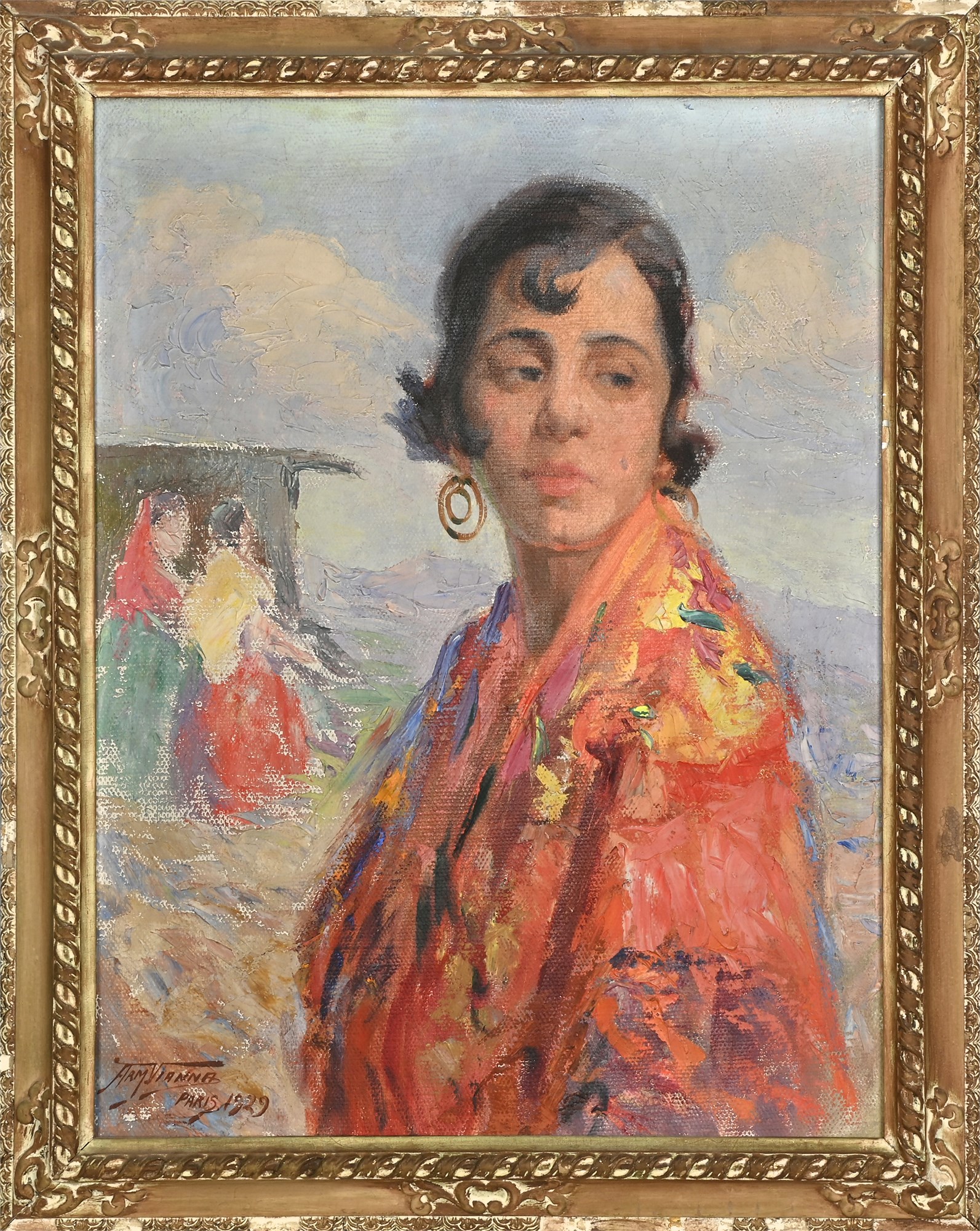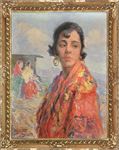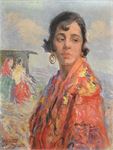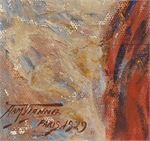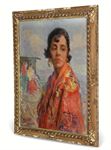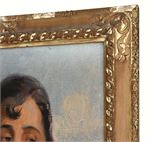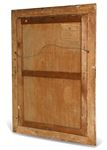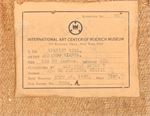Armando Vianna 'Spanish Girl' 1929 Oil View Watchlist >
- Winning Bid: $277.99
- 27 Bid(s) View Bid History
- High Bidder: Ironknot
Seller Accepts Credit Cards
Payment and pickup instructions will be available on your invoice (under "My Account") at the conclusion of this auction.
Lot # I149
System ID # 18629063
Start Date
End Date
3 Watching
Armando Vianna 'Spanish Girl' 1929 Oil
Title: Spanish Girl
Artist: Armando Vianna
Medium: Oil on Stretched Canvas
Exhibition: International Art Center of Roerich Museum, New York City (Exhibition No. 66)
Exhibition Label Verso
Signature: Signed lower left "Arm. Vianna Paris 1929"
The painting "Spanish Girl" by Armando Vianna, created in 1929 during his stay in Paris, captures the essence of a young woman with an enigmatic expression, draped in vibrant, colorful attire. The background is suggestive of a rustic scene, possibly alluding to a traditional Spanish or Mediterranean setting, with hints of other figures blurred into the composition. The use of bold, expressive brushstrokes and the interplay of light and shadow on the woman’s face and attire showcase Vianna’s mastery of impressionistic techniques, combined with a keen eye for detail and emotion.
This work is part of Vianna’s broader exploration of European themes during his time abroad, where he continued to refine his artistic techniques while engaging with the artistic movements of the time. The painting reflects a blend of traditional Brazilian realism with European impressionism, indicating Vianna's adaptability and his quest to integrate different artistic influences into his work.
Condition:
The painting itself is in good condition, maintaining vibrant colors and the integrity of the artist's brushwork. The original cast plaster and wood frame, however, is heavily worn and has several damaged sections, reflecting its age and history.
Size:
- Overall: 30" x 24"
- Visible: 25" x 19"
Historical Context:
Armando Vianna’s time in Paris was a pivotal period in his career, allowing him to immerse himself in the rich artistic culture of the city. His studies at the Académie de la Grande Chaumière and his interactions with the European avant-garde undoubtedly influenced his approach, as seen in this painting. "Spanish Girl" was later exhibited at the International Art Center of Roerich Museum in New York City, highlighting the international recognition of his work.
The exhibition label on the back of the canvas not only provides vital provenance information but also underscores the painting’s historical significance as part of Vianna's international exposure. This piece, priced at $100.00 at the time, reflects the market value of his work during this period, which has undoubtedly appreciated given the historical and cultural significance of Vianna’s contributions to Brazilian and global art. *The value of $100 in 1929 would be approximately $1,658 when adjusted for inflation to the year 2024.
About the Artist:
Armando Martins Vianna
Born: 1897, Rio de Janeiro, RJ, Brazil
Died: 1991, Rio de Janeiro, RJ, Brazil
Armando Martins Vianna was a prominent Brazilian painter, draftsman, and teacher whose work spanned several important movements in 20th-century art. Born in 1897 in Rio de Janeiro, Vianna was the son of Francisco Roberto Martins Vianna, a Portuguese man, and Leopoldina Carolina da Fonseca, the daughter of a freed slave. He began his artistic journey at a young age, working in his father's painting shop where he started by cleaning tools and painting commercial signs, horse-drawn carriages, and milk carts.
In 1911, Vianna enrolled at the Liceu de Artes e Ofícios in Rio de Janeiro, where he studied under the guidance of Professor Eurico Moreira Alves. He furthered his education at the National School of Fine Arts, studying with renowned artists Rodolfo Amoedo and Rodolfo Chambelland. His early works, including a 'still life' painted in 1913, were marked by a strong emphasis on drawing and faithful coloration, reflecting the academic training he received.
By 1921, Vianna had begun participating in the National Salon of Fine Arts (SNBA) with a landscape painting that showcased his emerging style. Determined to expand his artistic horizons, he won a prize in 1926 for his painting "Primavera em Flor," which allowed him to travel to Europe. In Europe, he exhibited in Lisbon and studied at the Académie de la Grande Chaumière in Paris, where he refined his skills in drawing and life modeling.
Vianna's work evolved over the years from traditional academicism to impressionism, with explorations into cubist modernism. However, he remained deeply committed to his roots in realism, producing a vast body of work that included landscapes, nudes, flowers, and religious scenes. His decorations of significant landmarks in Rio de Janeiro, such as the Catete Palace, the War Palace, and several churches, solidified his reputation as a versatile and skilled artist.
Throughout his life, Vianna received numerous accolades, including a gold medal at the Lisbon Fine Arts Society Salon in 1928 and a silver medal at the National Salon of Fine Arts in 1939. His work was recognized internationally, with one of his paintings being acquired by the International Art Center of the Roerich Museum in New York during his time in Paris.
Vianna's contributions to Brazilian art extended beyond his own creations. He was a dedicated teacher at the Instituto de Belas Artes in Rio de Janeiro, where he influenced a new generation of Brazilian artists for over 20 years. His impact on the art world was celebrated in 1983 with a retrospective exhibition marking 70 years of his painting career.
Despite the allure of modernism, Vianna remained true to his classical training, often integrating elements of impressionism and other modern styles without abandoning his commitment to realism. His works are spread across various Brazilian museums, preserving his legacy as one of Brazil's most esteemed painters.
Vianna's later years were marked by continued recognition, including a Diploma of Homage and Gratitude from then-President José Sarney in 1985 for his lifetime contributions to Brazilian art. He continued to work well into his 90s, leaving behind an indelible mark on Brazilian culture through his historical, religious, and allegorical paintings.
Armando Martins Vianna passed away in Rio de Janeiro in 1991 at the age of 94, having remained active in his art until his final days. His work continues to be celebrated posthumously, with major exhibitions and the establishment of the Armando Vianna Museum in São Paulo, ensuring that his contributions to Brazilian art will not be forgotten.
